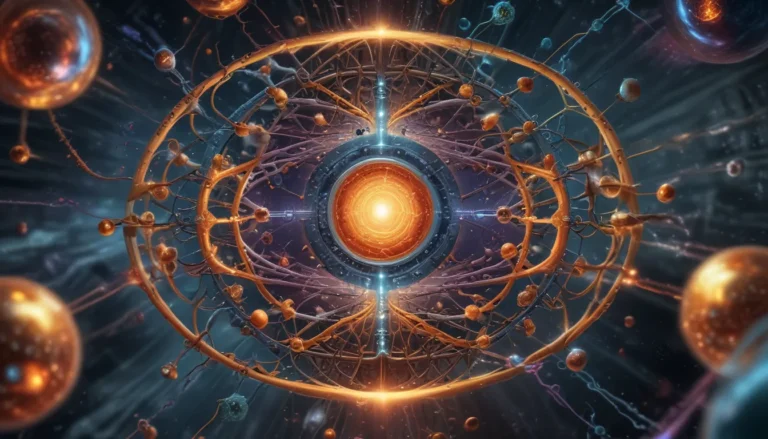A Note About Images: The images used in our articles are for illustration purposes only and may not exactly match the content. They are meant to engage readers, but the text should be relied upon for accurate information.
Particle physics is a captivating field that delves into the fundamental constituents of the universe and their intricate interactions. Scientists dedicated to unraveling the mysteries of particles and the forces governing their behavior lead us on a thrilling journey through the microscopic realm. This discipline sheds light on the hidden secrets of our reality, challenging and expanding our comprehension of the universe.
Unveiling Mind-Blowing Discoveries
The world of particle physics is an incredible tapestry of discoveries that astound and inspire. From the groundbreaking revelation of the Higgs boson to the mind-bending concepts of quantum superposition and entanglement, the realm of particles never fails to amaze us. Let’s dive into some astonishing facts that will broaden your horizons and defy your imagination.
The Discovery of the Higgs Boson
In 2012, particle physicists at the Large Hadron Collider in Geneva, Switzerland, made a historic breakthrough by discovering the Higgs boson, also known as the “God Particle.” This fundamental particle plays a crucial role in giving mass to other particles and confirms a key aspect of the Standard Model of particle physics.
Quantum Superposition: Being in Two Places at Once
Quantum mechanics introduces the concept of quantum superposition, where particles like electrons can exist simultaneously in multiple states or locations. This phenomenon challenges our conventional understanding of reality and opens up a realm of possibilities that push the boundaries of our perception of the universe.
Entanglement: Instantaneous Communication Across Vast Distances
Entanglement allows particles to communicate instantaneously with each other, regardless of the physical distance separating them. When two particles become entangled, a change in one particle will instantly affect the other, presenting a mysterious form of connectivity that defies classical physics.
Unraveling the Mysteries of Particle Characteristics
Particles in the world of physics display fascinating properties and behaviors that captivate the minds of scientists and enthusiasts alike. Let’s delve into some intriguing aspects of particle physics that shed light on the nature of matter and energy.
-
Antimatter Annihilation: Antimatter serves as the counterpart to normal matter, with particles possessing opposite charges to their conventional counterparts. When matter and antimatter collide, they annihilate each other, releasing a significant amount of energy in the process.
-
Neutrinos: Penetrating Subatomic Particles: Neutrinos are nearly massless particles that can traverse solid matter with ease. Their abundance and elusive nature make them intriguing subjects of study in the realm of particle physics.
-
The Standard Model: Describing Fundamental Particles: Scientists have developed the Standard Model to elucidate the fundamental building blocks of matter and the forces that govern their interactions. While the model successfully describes known particles and their behaviors, it leaves some mysteries unanswered, paving the way for further exploration.
Unveiling Theoretical Frameworks and Enigmatic Phenomena
Theoretical frameworks in particle physics offer intriguing perspectives on the nature of the universe, expanding our understanding of reality beyond conventional boundaries. Let’s explore some fascinating concepts that challenge our perception of the fundamental nature of particles and forces.
-
String Theory: Vibrating Strings as Fundamental Particles: String theory proposes that particles are not point-like entities but rather tiny loops of vibrating strings. This unification theory aims to merge general relativity and quantum mechanics, presenting a holistic view of the universe.
-
Dark Matter: Invisible Cosmic Substance: Dark matter remains an enigmatic substance that comprises a significant portion of the universe’s mass. Unlike conventional matter, dark matter does not interact with light or electromagnetic radiation, rendering it invisible and challenging to detect directly.
-
Quantum Tunneling: Defying Classical Constraints: Quantum tunneling allows particles to pass through energy barriers that classical physics would deem impenetrable. This phenomenon plays a vital role in nuclear fusion reactions and various aspects of particle physics.
Embracing the Intricacies of Particle Interactions and Forces
The interactions between particles and the fundamental forces of nature shape the fabric of our universe, unveiling intricate mechanisms that govern the behavior of matter and energy. Let’s explore some key forces and phenomena that define the realm of particle physics.
-
Coherent Superposition: Quantum Entanglement within a Particle: Coherent superposition refers to a particle existing in multiple states simultaneously, revealing the intriguing nature of quantum mechanics. This concept finds applications in quantum computing, revolutionizing computational capabilities.
-
Weak Nuclear Force: Driving Radioactive Decay: The Weak Nuclear Force plays a pivotal role in processes such as beta decay, where unstable nuclei emit electrons or positrons. This force orchestrates the transformation of one elementary particle into another, contributing to the natural decay of radioactive elements.
-
Particle-Wave Duality: The Dual Nature of Particles: The concept of particle-wave duality highlights the ability of particles like electrons and photons to exhibit both particle-like and wave-like behaviors. This fundamental aspect of quantum mechanics challenges our traditional view of particles as discrete entities.
Capturing the Essence of Particle Accelerators and Early Universe Conditions
Particle accelerators serve as powerful tools for recreating extreme conditions akin to those just after the Big Bang, enabling scientists to study fundamental processes and particles. Let’s uncover the intriguing capabilities of particle accelerators and their significance in unraveling the mysteries of the universe.
- Recreating Early Universe Conditions: By colliding particles at high energies, particle accelerators recreate the primordial conditions that existed shortly after the Big Bang. This allows scientists to delve into the fundamental aspects of the universe’s evolution and composition.
These astonishing facts about particle physics offer a glimpse into the captivating world of scientific inquiry that continues to push the boundaries of human knowledge and understanding. From the mysterious nature of dark matter to the intricate workings of particle interactions, particle physics remains a fascinating field with immense potential for technological advancements and cosmological insights.
Embarking on a Journey of Exploration and Discovery
Particle physics serves as a gateway to unlocking the secrets of the universe at its smallest scales, offering profound insights into the fundamental nature of reality. As we venture into the subatomic world, we encounter a realm filled with wonders and mysteries waiting to be unveiled.
The commitment to unraveling the complexities of matter and energy has tangible implications in various fields, from medicine to engineering, paving the way for groundbreaking advancements in technology. Embrace the awe-inspiring journey through particle physics and witness the marvels of the universe unfold before your eyes.
Conclusion: Embracing the Marvels of Particle Physics
Particle physics transcends conventional boundaries, providing a gateway to exploring the fundamental elements of our universe. The profound discoveries and mind-bending phenomena within this field challenge our perceptions and fuel our curiosity to delve deeper into the mysteries of the cosmos.
As we continue to uncover the secrets of the subatomic world, particle physics holds the key to unlocking new vistas of knowledge and understanding. The exploration of particle interactions and fundamental forces enriches our comprehension of the universe, reshaping our perspectives on reality and existence.
Prepare to be astounded and captivated by the incredible world of particle physics as you embark on a journey of discovery and enlightenment. The mysteries of particles and forces await your exploration, inviting you to witness the extraordinary marvels that define the fabric of our reality.
FAQs: Unveiling Insights Into Particle Physics
-
What is particle physics?
Particle physics is a branch of physics that investigates the fundamental particles and forces composing the universe. -
What are fundamental particles?
Fundamental particles are the smallest building blocks of matter, encompassing quarks, leptons, and bosons. -
What is the Higgs boson?
The Higgs boson is a particle that imparts mass to other particles and was discovered at the Large Hadron Collider in 2012, validating the existence of the Higgs field. -
What is dark matter?
Dark matter is a mysterious form of matter that does not interact with light or electromagnetic radiation, constituting a significant portion of the universe’s mass. -
Are there multiple dimensions?
Theories in particle physics propose the existence of dimensions beyond the familiar four dimensions of space and time, presenting intriguing possibilities. -
How do particle accelerators function?
Particle accelerators employ electromagnetic fields to accelerate charged particles to high velocities, enabling scientists to study their properties and interactions. -
What are the practical implications of particle physics?
Research in particle physics has led to advancements in medical imaging, radiation therapy, and the development of innovative materials and technologies. -
How do scientists detect particles?
Scientists employ detectors such as particle detectors and electromagnetic detectors to observe the properties and behaviors of particles. -
What is the Standard Model of particle physics?
The Standard Model is a comprehensive theory that elucidates the fundamental particles and forces of nature, offering a unified framework for understanding the universe. -
Are there different types of quarks and leptons?
Yes, there are six distinct types of quarks and leptons, each possessing unique characteristics and masses.
Embark on a journey through the remarkable realm of particle physics, where the mysteries of the universe await your exploration and discovery. Engage with the wonders of subatomic particles and fundamental forces that shape the fabric of reality, and let the marvels of scientific inquiry guide you to new horizons of knowledge and understanding. Join us in unveiling the enigmatic world of particle physics and witness the awe-inspiring beauty that lies within nature’s fundamental building blocks.
Experience the thrill of discovery and the joy of enlightenment as you navigate through the incredible universe of particle physics, where each revelation and insight paints a vivid portrait of the intricate workings of the cosmos. Embrace the mysteries, unravel the enigmas, and embark on a transformative journey through the captivating wonders of particle physics.
By crafting a comprehensive and engaging exploration of the astonishing facts surrounding particle physics, readers can immerse themselves in the captivating world of subatomic particles and fundamental forces. Through a blend of informative insights, intriguing concepts, and practical applications, the transformative nature of particle physics unfolds, inviting individuals to embrace the wonders of scientific inquiry and expand their horizons of knowledge and understanding.






